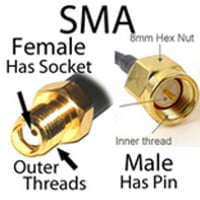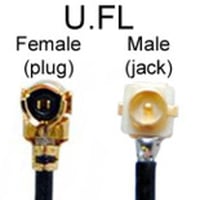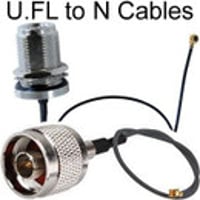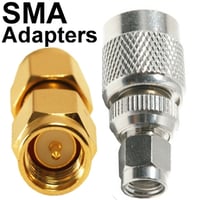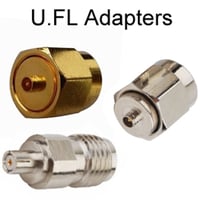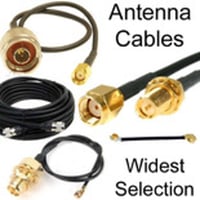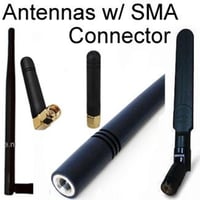Large Enclosures: NEMA Rated and UL Listed
Large Enclosures w/ 120V or 240V AC Outlets:
Large NEMA enclosures to securely protect outdoor electronics: These high-specification enclosures, often equipped with vents, heating, and fans, are equipped with insulation performance and thermostatic control to ensure that the functioning of your equipment or network is safeguarded. The NEMA system of ratings makes selecting the right large enclosure for your equipment easy.
Waterproof / Weatherproof Outdoor Enclosures with Internal Electric Outlets
Large outdoor wireless enclosures with 120 or 240 volt AC outlets are a specialist type of electrical enclosure. These metal or plastic lidded and hinged boxes are used to provide housing and route power cabling and supply for a wide range of wireless networking equipment including routers, access points, antennas, signal boosters, and any attendant thermostatic controls. They are also called NEMA enclosures, due to their associations with the National Electrical Manufacturers Association (NEMA) certification system and wireless boxes. The term NEMA enclosures can be used to describe enclosures that are not NEMA-rated.
These enclosures vary in size and specifications with large wireless enclosures with mains AC power outlets providing venting, heating, and cooling to provide a thermostatic and moisture controlled interior environment. They are used for both indoor and outdoor wireless networking installations and are manufactured to be able to withstand extremes of temperature and the ingress of moisture and dust. Our selection of large weatherproof enclosures:
- Have market-leading fabrication and structural integrity.
- Are fully NEMA rated (as explained below) to provide robust protection from the outdoor environment.
- Will not interfere or diminish the performance of wireless equipment installed within them.
- Have secure latches (that can be padlocked) and also allow convenient access to personnel for maintenance and repairs.
- Have electrical components and wiring that is compliant with the EU Restriction on Hazardous Substances (RoHS) legislation and Conflict Minerals Regulations.
Large electronics enclosures can be mounted in a variety of ways. They can either be wall-mounted or pole-mounted with the correct brackets and bolts. Alternatively, it can be laid flat without compromise of performance. Within the enclosure, the wireless equipment can be mounted on a removable mounting panel also.
Key components and features of large enclosures with 120V or 240V AC outlets
- Outer case
The outer housing of these enclosures for wireless networking is made from durable plastic that will not block radio frequency signals. Plastics used for such enclosures include:
- Acrylonitrile Butadiene Styrene (ABS)
- Polycarbonate
- Polystyrene
- Polyvinylchloride (PVC)
- Polypropylene
The enclosure plastics may also have UV-resistant and flame retardant finishes.
- Cooling fan
High specification wireless enclosures have integrated fan modules that provide responsive cooling for powered electronic equipment so that a thermostatically-controlled environment is continually maintained. Fans are effective at keeping critical wireless networking gear within the temperature range needed for optimal performance and can not only prolong the life of wireless devices but also save energy. The fan module is often vented and mounted inside the door of the electronics enclosure where it can draw in large volumes of air. Alternatively, enclosure fans are mounted on panels or DIN rails within the enclosure.
- Filters
These enclosures carry one or more electronics air filters which are vital for keeping moisture and dust out of the enclosure while air is drawn in or pushed out by the fan. Disposable polyester air filters arrest dust ingress and can be readily replaced. Many graded filters are also treated with flame-retardants to reduce fire risk. They are also useful for protecting personnel fingers from the fan.
Mounting plates (also known as backplates or perforation plates) sit within the enclosure and provide a punch-hole surface for secure mounting of electronic components. They are usually made from lightweight aluminum. It will come with the screws needed for screwing the panel into the enclosure. Electrical apparatus can be directly fixed to the panel or DIN rails can be installed. DIN rails are advantageous as they provide a quick and convenient system for mounting internal equipment securely. DIN screw-in rails have standardized dimensions and work with a broad range of mounting hardware.
- Internal AC outlets
Powered outdoor wireless enclosures carry internal power outlets to provide mains AC power for wireless access points and routers, and supplementary fans and heaters. These surge-protected power outlets are wired in and fixed to the metal mounting plate of the enclosure. These powered enclosures accommodate either 120 Volts, which is common in the US, or up to 240V with an alternate design.
- H-cut and D-cut holes
These holes in the base of the enclosure can be used for routing cables with a suitable grommet, passing an N-type bulkhead connector, or can be blocked with a suitable H/D-Cut NEMA Hole Plugs if redundant.
- A grounding lug
Wireless devices that are installed within the NEMA enclosure must be properly ground for not only safety purposes but to ensure they operate properly and within any EMI requirements. A pre-attached grounding lug facilitates the connection of a grounding conductor to its counterpart grounding electrodes.
- Cable conduit
Cabling can be routed into and out from the enclosure while maintaining its weatherproofing using sealed conduits and glands that also protect the cables from twisting or abrasion damage. Cable conduits are threaded connectors that pass through the raw outlet hole in the enclosure. They are convenient and secure. Each conduit or gland possesses a nut that is tightened down at one end and a sealed cap at the other that also screws tight for a good fit. The cable can then be passed through the conduit.
- Intake exhaust covers
Good ventilation is critical to the preservation of the performance of outdoor wireless installation and large enclosures that have AC power will require good air circulation to keep the wireless components cool. Air can be drawn by integrated fans into the enclosure via the vents and filters described above, with an intake exhaust cover over the necessary vents, impeding the ingress of larger particles and dust while directing the flow of fresh air into the enclosure. These exhaust covers are typically mounted on the door of the unit.
- Quick-release lockable latches
Large NEMA enclosures come with a range of locking mechanisms that keep the enclosure firmly shut and also keeping the enclosure safe from unauthorized access and vandalism. The enclosure latch or lock also has to deliver a level of secure closing that does not compromise the NEMA or Ingress Protection rating for the enclosure.
Why are large enclosures with 120 volt or 240 volt AC outlets important?
Over the past 20 years, the expansion of Wireless Local Area Networks (WLAN) has been near exponential with wireless access to the internet expected in settings as diverse as parks, restaurants, factories, schools, and airports. Along with this growth, expertise and the technical execution of public and private WLANs has become more sophisticated and has necessitated the installation of Wireless Access Points (WAPs or AP) in a range of locations to provide the wireless connectivity demanded by modern life and industry. The APs and routers are interfaces between an Ethernet cabled network and wireless internet access, and so need to be advantageously positioned throughout buildings, harsh industrial environments, or outdoor spaces as required.
Long-term installation of wireless networking equipment and their associated connections requires suitable housings and enclosures that can protect the wireless installation from physical impacts, environmental exposures, and the ingress of moisture and dust that can age and degrade the equipment. Repairing and replacing compromised antennas, cables and routers are costly in both money and network downtime, so a high-specification enclosure proves great value for money over time! Large wireless enclosures, such as those used to house APs are climate controlled meaning that they can withstand the extremes of temperature that can be encountered throughout the year. The mounting cable and outlets provided help keep the orderly arrangement and routing of cables and components in the interior of the enclosure.
The wireless equipment kept in an enclosure often requires line of sight visibility with maximum exposure so it is viable that the housed electronics are kept secure and tamperproof.
Wireless enclosures are made from durable plastics, that, unlike metal, will not degrade signal strength, and their smart and unobtrusive appearance gives the area where they are installed a smart aesthetic. One properly fitted, an entire enclosure complete with devices and cables can be securely mounted where wireless connectivity is needed. An enclosure with mains AC power connections can be relied on for power if an access point does not receive its power through the network connection.
Large enclosures protect wireless installations from a range of environmental hazards
- Large enclosures with 120V or 240V AC outlets protect equipment from moisture
These enclosures deliver reliable protection against liquids and precipitation like rain, snow, or ice build-ups. In humid environments moisture can enter devices and cool on their exposed parts, causing corrosion and degradation. Corrosion is a progressive process and once started cannot be stopped, so prevention is key. NEMA enclosures are rated according to their level of protection against water and moisture ingress, using seals and fans to keep the internal environment of the enclosure properly ventilated and dry.
- The effects of air pollution are prevented by using a large wireless NEMA enclosure.
Sulfur dioxide, acid rain, and other air pollution chemicals and atmospheric gases will rapidly age an exposed installation. This is a significant problem in high urban environments with high traffic or industrial areas where emissions are high. These substances cause a build-up of tarnish or frank corrosion on connectors which can begin to alter their electrical performance and disturb the wireless connectivity provided by the assembly.
- Large enclosures with 120V or 240V AC outlets will keep dust and particulate matter out.
Keeping particulate matter and dust away from your wireless equipment will prolong its lifespan. It is vital for manufacturing and industrial environments where grime can build up rapidly. Dust is a key cause of short-circuiting and failure of wireless and other electronic devices as it gradually builds upon exposed components and seeds corrosion or causes mechanical changes, for example by settling in the threads and crimping of radio frequency connectors. Moisture also accelerates the damage caused by dust like soot, sand, or mineral salts.
- With a large electronic enclosure wireless equipment is protected from temperature extremes.
Every component within a wireless networking device will have specified limits on the extremes of temperature that it can withstand before becoming dysfunctional. Keeping equipment within an enclosure will shield it from the outside air temperature, whether hot or cold. Temperature extremes will affect the performance of WiFi and other wireless networking equipment so sourcing a NEMA enclosure with thermal control is a prudent investment. Powered units within the enclosure can easily overheat, again causing damage to delicate electronic components. An integrated fan works to dissipate excess heat through strategically positioned vents. For extremely low temperatures heat strips and 120V or 240V AC enclosure heaters can maintain a steady temperature within the enclosure when the external temperature drops. For most enclosures heating will require mounting and wiring-in, but some models have it concealed behind the mounting plate.
Use of the NEMA rating system provides confidence that a wireless networking installation is properly protected
Several rating systems exist for describing the level of protection conferred by a particular enclosure. Notable examples include Ingress Protection (IP) Codes and the Underwriters Laboratories (UL) certifications. These weatherproof and waterproof ratings, carried by large wireless enclosures, are used by manufacturers and distributors to specify the level of protection provided by the enclosure. They objectively categorize the enclosure’s impermeability to moisture and dust and its ability to withstand temperature extremes and impacts.
- National Electrical Manufacturers Association (NEMA) ratings
This North American rating system is widely used for the grading of electrical and wireless enclosures. NEMAs standardized ratings outline the key features of a broad range of enclosures based on their ability to withstand water, chemicals, dust, and other intrusions. The NEMA rating of an enclosure can be used to achieve a more precise match between the enclosure and its intended application so that the equipment inside is properly protected.
NEMA ratings run from 1 to 13 and are used for both indoor and outdoor enclosures in a range of conditions:
- NEMA 1 enclosures are used indoors and primarily protect the equipment they hold from the ingress of dust, dirt, and other foreign objects. They also are rated for protecting personnel that handles the enclosure from coming into contact with hazardous parts.
- NEMA 2 enclosures are also for indoor use. In addition to their protection against dirt, they are resistant to light exposure to water (e.g. droplets and splashes).
- NEMA 3 rated enclosures are for outdoor use and can withstand rain, sleet, and the build up of ice on the outside of the enclosure. They are not fully waterproof.
- NEMA 3R latched, outdoor wireless enclosures also protect against precipitation, ice, and splashes or drips of water. They do not have seals or gaskets and are not fully waterproof
- NEMA 3SX wireless enclosures are outdoor enclosures that provide protection from wind-blown dust, rain, and sleet and have added protections to maintain functionality even when the enclosure is covered in ice. The X designation denotes that the enclosure confers corrosion protection.
- NEMA 4 rated enclosures are for outdoor use. These wireless enclosures have greater protection against water and moisture ingress and can withstand hose directed water spray in addition to the protections outlined above. Corrosion protection is indicated if and X is added to the rating.
- NEMA 5 indoor enclosures protect their contents from splashes and drips of water and other non-corrosive liquids and also settling dust and falling dirt.
- NEMA 6 enclosures can be used in either indoor or outdoor settings and have greater water resistance than the previous levels. NEMA 6 enclosures withstand hose directed water and short periods of immersion at a limited depth.
- NEMA 6P wireless enclosures can tolerate prolonged submersion in water.
- NEMA 7, 8, and 9 large enclosures are designed for hazardous environments and are explosion-proof, oil proof, and dust ignition-proof respectively.
- NEMA 10 enclosures are specifically rated inline with the health and safety requirements outlined for mines by the Mine Safety and Health Administration.
- NEMA 11 enclosures can withstand immersion in oil and contact with corrosives and other industrial substances.
Frequently Asked Questions
Are there any other items required for protecting wireless equipment outdoors?
There are many devices and accessories that can be used to further protect an outdoor wireless networking installation. These items will work well with the selection of large wireless enclosures shared above.
- N-type connector surge protection devices are essential for protecting sensitive electronics from an unexpected surge in voltage. N connector lightning connectors can be readily inserted into D-cut holes on many models of wireless enclosure. They then facilitate the easy coupling of compatible coaxial cable, for in-line protection from the antenna to the device.
- Grommets are useful for protecting the edges of enclosure outlets which may be sharp and able to damage cables.
- Glands: cable glands provide sealed practical access points to the enclosure that can be used for routing cable, USB, fiber, SIM, and terminal block.
- Coaxial sealant tape is a moldable weatherproof tape that can be wrapped around connectors and cabling that is outside of the assembly. It shrinks and molds to provide a waterproof and thermally stable seal.
- Adhesive rubber gaskets can also be purchased to improve the weatherproofing of an enclosure. The seal can simply be cut to size and stuck to the enclosures opening.
- Silicone grease or dielectric grease is used to waterproof radio frequency connectors. It can be applied to cable assemblies to completely impede moisture ingress and protect against corrosion.
In Conclusion:
Large outdoor wireless enclosures with power supply are a critical investment to safeguard the performance of a wireless networking installation. High-specification large enclosures are equipped with the hardware and ratings to ensure a protective thermally-controlled environment for sensitive electronic equipment, complete with secure and safe connectivity to a mains power supply.
NEMA Ratings for Electrical Enclosures:
NEMA (National Electrical Manufacturers Association) provides standards for use in classifying electrical enclosures and housing in North America for industrial applications. NEMA rates products protection against hazardous environmental elements like dust, water, temperature, and corrosive agents. NEMA ratings define the acceptable functionality of protective enclosures in hazardous conditions.
NEMA enclosures are classified according to their protective characteristics and assigned designated numbers and letters to represent their protection level.
NEMA standards are not equivalent to IP ratings. NEMA standards are concerned with general functionality in hazardous conditions, while IP standards are centered around weatherproofing and protection from solids and water.
A rough equivalence comparison can be made of NEMA and IP standards:
| IP | NEMA |
| IP20 | 1 |
| IP22 | 2 |
| IP55 | 3, 3X, 3S, 3SX |
| IP24 | 3R, 3RX |
| IP66 | 4, 4X |
| IP53 | 5 |
| IP67 | 6 |
| IP68 | 6P |
| IP54 | 12, 12X, 13 |
What are large NEMA enclosures?
Large NEMA-rated enclosures are a type of electrical or electronic enclosure that is rated following the National Electrical Manufacturers Association (NEMA) proprietary standards for enclosures. The NEMA accreditation described further on denotes the enclosure as meeting all the requirements specified by NEMA. The term NEMA box may also be used to describe these electrical enclosures, though not all electronic enclosures described as NEMA boxes carry an official rating, but rather describe the enclosure as being suitable for a harsh environment.
Large NEMA enclosures provide competent housing for the installation of electronic devices such as networking equipment in hazardous or outdoor environments where sensitive technology is vulnerable to environmental exposure and damage. NEMA enclosures are specifically designed and manufactured to be able to withstand the ingress of dirt, dust, and moisture that can corrode electronics. The housings are also able to protect equipment from solar radiation, extremes of heat and cold, and impacts.
RoHS and Conflict Minerals Regulation compliant large NEMA enclosures
Our extensive selection of large electronic enclosures are manufactured to a high standard using materials of good provenance and manufacturing methods that are compliant with the following pieces of domestic and international legislation:
- Restriction of Hazardous Substances (RoHS) directive / Directive 2002/95/EC
- The Conflict Minerals Regulation
- Section 1502 of the Dodd-Frank Act
Large NEMA enclosure size and dimensions
It is important to select an enclosure of the right size in which to house your assembly. Large electronic enclosures have a length (or height depending on orientation), of at least 12 to 18 inches. Extra-large NEMA boxes are bigger still with a length of 18 inches and upwards.
These rugged large enclosures provide enough room for spacious and secure mounting of a range of components. Most large enclosures have a metal back panel that may or may not be pre-drilled for mounting items within the enclosure. DIN rails can be readily installed for a reliable and secure mounting system. Accessories and attachments can be procured to mount the enclosure on a wall or pole as required. Enclosure knockouts are provided with grommets and custom knockouts for cable glands, couplings and vents can also be made.
They can be customized with a variety of latching options and design, as well as robust hinges that are capable of holding the enclosure door open while personnel work on the equipment.
Some enclosures are powered with 120V or 240V mains power and a convenient outlet within the enclosure. Powered NEMA boxes can also drive ventilation fans and heaters for precision thermostatic control of the internal environment.
Large NEMA box applications
The applications for a large electrical enclosure are quite varied and go beyond networking and telecommunications.
Because the enclosures are rated for their strong seal and structural integrity, they are suitable for a range of environments including outdoor locations, wash down areas, catering, medical and industrial settings where there may be exposure to volatile or corrosive substances. They are reliable over a wide temperature range (e.g warehouse refrigeration) and perform just as well in cold icy conditions as in humid or dusty and dry ones.
The room these large NEMA boxes provide is ideal for the housing of complex and critical equipment and components such as:
- Large batteries
- Machinery control consoles
- Junction boxes
- Wiring boxes
- Surge suppression devices
- Industrial consoles
- Marine electronics
- Programmable logic controllers
Large enclosure materials
Several materials have the physical properties and machinability for manufacturing high-quality electrical enclosures that can withstand a range of environmental challenges. The selection of a metal or plastic material for your enclosure will depend on the type of equipment that is housMetal versus plastic for large NEMA enclosures
NEMA enclosures are either made from metal or plastic, with both types of material capable of housing equipment following the NEMA standards. The choice of a plastic NEMA enclosure versus metal will largely depend on the application for which it is used. Here are some key differences between the two materials:
Plastics
- Allow radio frequency energy to freely pass through the walls of the enclosure, meaning they can house antennas and other forms of radio frequency equipment.
- Easy to shape and customize.
- Generally lightweight materials.
- Easier than metal to damage or vandalize.
- Over time plastics will gradually deteriorate.
Metals (steel, aluminum)
- Strong, resistant to physical impacts and vandalism.
- If required, metal delivers almost total shielding from electromagnetic interference.
- Metals have high thermal and electrical conductivity.
- Metal boxes often need to be grounded.
- Metal enclosures require more complex manufacturing processes and may come at a premium.
- Metals are heavier than plastics.
- They are unsuitable for housing antennas or equipment that are designed to radiate or receive radio frequency signals as the enclosure acts as a barrier.
Large plastic NEMA enclosure materials
- Fiberglass reinforced polyester (FRP) is a superior material for electrical and electronic enclosures and usually carries a premium as part of high-specification enclosure designs. FRP is impregnated with glass fibers that differ according to the use of the plastic. E-glass is used for electrical applications, S-glass is added for strength, and C-glass has superior corrosion resistance. These are combined with polyester resins to create strong and stiff enclosures, with strength enhanced by increasing percentages of fiber. Glass fiber-reinforced plastic is advantageous for electrical installations because of its insulative properties. It is resistant to weathering, with good fatigue-resistance and strength retention over time. With the addition of UV stabilizers, fiberglass-reinforced polyester resists photodegradation.
- Polycarbonate is another high-quality thermoplastic that is widely used for enclosures because of its durability and robustness. It is clear, but it can be colorized and have UV stabilizers and fire retardants added for a specified finish. It is thermally stable over a wide range of temperatures (40 to 248 Fahrenheit / 4 to 120 degrees Celsius) and resists degradation from sunlight. This high-performance plastic has exceptional impact resistance, is non-corrosive and good resistance to solvents. It is also lightweight, making it ideal for mounting at height.
- ABS (Acrylonitrile Butadiene Styrene) is a cost-effective plastic for enclosures that are lightweight and resilient. It is strong and stiff and has demonstrable durability in a range of environments, particularly outdoors. It withstands impacts and has high tensile strength as well as good scratch resistance and chemical resistance. Over time, ABS has a slightly greater vulnerability to photodegradation by sunlight. ABS will provide good heat resistance though cannot tolerate temperatures as high as other plastics. Its temperature range is 0 to 176 degrees Fahrenheit (-17 to 80 degrees Celsius).
- PVC Polyvinyl Chloride (PVC)a thermoplastic with comparable strength to polycarbonate, while typically being more cost-effective. It is machinable and easily shaped into a wide range of enclosure dimensions and designs, but retains rigidity and stiffness. PVC also provides great thermal insulation and is resistant to the degrading effects of prolonged sunlight exposure. This lightweight plastic is intrinsically flame-resistant and will self-extinguish, which is a desirable property for materials used to house electrical equipment.
Large metal NEMA enclosure materials
- Stainless steel fabricated NEMA boxes are a hardwearing and resilient option for rugged outdoor enclosures. As its name describes it resists corrosion and staining due to its significant chromium content, which resists oxidation (rusting). The stainless steel is manufactured to several grades and maybe powder coated for marine, corrosive or industrial environments, or left bare. Stainless steel enclosures have a significant hardness and deliver good protection from moisture, dust, UV, chemicals, and temperature extremes. Where they are well sealed, these enclosures prove resilient in marine or washdown environments. They have significant longevity and service life and are unlikely to deteriorate over years and decades in place. They deliver outstanding value in comparison to other types of steel.
- Die-cast aluminum is a particularly resilient choice for electrical enclosures and despite being lighter in weight than steel, aluminum has a good strength-to-weight ratio. This high-quality metal is formed into enclosures by molding hot metal under pressure and produces a precision finish to the enclosure parts. It works well in harsh environments and can tolerate high operating temperatures. Over time it retains its favorable strength stiffness and hardness and withstands corrosion well.
Why are large NEMA-rated enclosures important?
- The NEMA rating system benefits manufacturers, distributors, retailers, and users.
Purchasing enclosures that are built in accordance with authentic NEMA standards provides confidence that the enclosure will deliver the required level of protection for the equipment it houses. The NEMA standards not only specify the degree of environmental protection an enclosure delivers, but they also detail vital safety standards to protect personnel that handle the box and its contents.
When selecting an enclosure, a NEMA rating assists in the selection of the appropriate model. The provision of set standards means that both the manufacturer and customer can refer to a clear description of the capabilities and attributes of an enclosure.
- When selecting an enclosure size matters.
Sizing is important for enclosures as too much or too little space clearance can affect the sensitive or live equipment housed within the enclosure. If the enclosure is too small, the packing density of components and devices is increased. With this comes the potential for unwanted electromagnetic interference and overheating. Overheating is a problem that can become hard to manage in a tightly packed enclosure where there is little airflow to allow thermal dissipation. Conversely, not only is an oversized enclosure going to add to costs, it will take up valuable space or real estate in outdoor settings. In some cases, equipment mounted within an enclosure that is too big may run the risk of becoming jolted or damaged by impacts.
The prevention of corrosion and its causes is critical.
Corrosion is a progressive chemical degradation that affects metal components within electronic equipment. Once started, it cannot be stopped and will proceed through cables and wires and spread within equipment until they are destroyed. Often corrosion damage is only picked up when there has been significant damage to an electronic device. Impaired equipment often becomes dysfunctional, before visible evidence of damage is present with the corrosion of connectors and other components causing changes in resistance, leakage currents, short-circuiting and frank breakdown.
By housing and enclosure properly in a NEMA-rated enclosure, networking equipment, and electrical devices are protected from the causative factors that drive the corrosion process.
- Moisture is the primary driver of corrosion and works with airflow to corrode any exposed metal on which it alights. In high humidity environments, corrosion is accelerated.
- Dirt and dust can alight on metal surfaces and act as a humectant, attracting water to the salts that may be present in the dust to cause corrosion.
- Air pollution from vehicles or industry exhaust contains corrosive chemicals which can alight on components as particulates or within acid rain.
- Marine air is salt-laden and deposited salt will creep along and corrode exposed metal.
- Excessive sunlight causes photodegradation of plastic cable jackets and housings that can leave the metal unprotected. Temperature extremes also age components and cause condensation.
- Mechanical stress causes damage to cables and connectors that make them vulnerable to corrosion.
Enclosures that are resistant to both water and dust can effectively protect valuable equipment from these corrosive factors, which prolongs the service life of the equipment and saves money on costs and downtime.
Understanding the NEMA system - a closer look
The NEMA organization has an industry-led membership consisting of engineers, technicians, scientists, and business leaders. They have the experience and expertise to develop and deliver detailed standards that define the construction, composition, safety, tolerances, performance, and operating characteristics of electrical enclosures. The proprietary published standards that refer to electronic enclosures like the selection provided here are the NEMA Standard 250 Enclosures for Electrical Equipment. Below, we outline the key ratings for our large NEMA enclosures:
Type 1 NEMA enclosures
- Are for use indoors.
- Protect the components and equipment they house from the ingress of solid foreign objects.
- Prevent accidental personnel access to hazardous parts within the enclosure.
Type 2 NEMA enclosures
- Are for use indoors.
- Protect the components and equipment they house from the ingress of falling dirt.
- Protect against splashing and dripping water.
- Prevent accidental personnel access to hazardous parts within the enclosure.
Type 3 NEMA enclosures
- Can be used for both indoor and outdoor use.
- Protect the components and equipment they house from the ingress of falling dirt and windblown dust.
- Provide protection against rain, sleet, and snow and resilience against the formation of ice on the enclosure.
- Prevent accidental personnel access to hazardous parts within the enclosure.
Type 3R NEMA enclosures
- Can be used for both indoor and outdoor use.
- Protect the components and equipment they house from the ingress of falling dirt.
- Protection against windblown dust is omitted.
- Provide protection against rain, sleet, and snow and resilience against the formation of ice on the enclosure.
- Prevent accidental personnel access to hazardous parts within the enclosure.
Type 3S NEMA enclosures
- Can be used for both indoor and outdoor use.
- Protect the components and equipment they house from the ingress of falling dirt and windblown dust.
- Protect against rain, sleet, and snow and will remain operable when the enclosure is ice-laden.
- Prevent accidental personnel access to hazardous parts within the enclosure.
Type 3X NEMA enclosures
- Can be used for both indoor and outdoor use.
- Protect the components and equipment they house from the ingress of falling dirt and windblown dust.
- Provide protection against rain, sleet, and snow and resilience against the formation of ice on the enclosure.
- Provide additional protection against corrosion.
- Prevent accidental personnel access to hazardous parts within the enclosure.
Type 3RX NEMA enclosures
- Can be used for both indoor and outdoor use.
- Protect the components and equipment they house from the ingress of falling dirt.
- Protection against windblown dust is omitted.
- Provide protection against rain, sleet, and snow and resilience against the formation of ice on the enclosure.
- Provide additional protection against corrosion.
- Prevent accidental personnel access to hazardous parts within the enclosure.
Type 3SX NEMA enclosures
- Can be used for both indoor and outdoor use.
- Protect the components and equipment they house from the ingress of falling dirt and windblown dust.
- Protect against rain, sleet, and snow and will remain operable when the enclosure is ice-laden.
- Provide additional protection against corrosion.
- Prevent accidental personnel access to hazardous parts within the enclosure.
Type 4 NEMA enclosures
- Can be used for both indoor and outdoor use.
- Protect the components and equipment they house from the ingress of falling dirt and windblown dust.
- Watertight with protection against rain, sleet and snow, and ice.
- Prevent accidental personnel access to hazardous parts within the enclosure.
Type 4X NEMA enclosures
- Can be used for both indoor and outdoor use.
- Protect the components and equipment they house from the ingress of falling dirt and windblown dust.
- Watertight with protection against rain, sleet and snow, and ice.
- Provide additional protection against corrosion.
- Prevent accidental personnel access to hazardous parts within the enclosure.
Type 5 NEMA enclosures
- Can be used for both indoor and outdoor use.
- Dust-tight: protect the components and equipment they house from the ingress of falling dirt and windblown dust.
- Protection against splashing water, rain, sleet and snow and ice
- Prevent accidental personnel access to hazardous parts within the enclosure.
Type 6 NEMA enclosures
- Can be used for both indoor and outdoor use.
- protect the components and equipment they house from the ingress of falling dirt and windblown dust.
- Protection against splashing water, rain, sleet and snow and ice
- Watertightto temporary submersion and water sprayed from a hose. Not intended for continuous submersion.
- Prevent accidental personnel access to hazardous parts within the enclosure.
Type 6P NEMA enclosures
- Can be used for both indoor and outdoor use.
- Dust-tight: protect the components and equipment they house from the ingress of falling dirt and windblown dust.
- Protection against splashing water, rain, sleet and snow and ice
- Watertightto prolonged submersion and water sprayed from a hose. Not intended for continuous submersion.
- Prevent accidental personnel access to hazardous parts within the enclosure.
Frequently Asked Questions:
Are there other comparable rating systems to NEMA?
- Ingress Protection (IP) Codes refers to IEC60529 and EC60529 and is a rating system that specifies the degree of protection an enclosure provides against the ingress of dust, dirt, moisture, and other intrusions. IP ratings usually carry 2 digits. The first refers to the ingress of foreign objects and the second against liquids. IP67 and IP68 are ratings that specify an item as being watertight or waterproof.
- Underwriters Laboratories or UL codes is a Federally recognized system of certifications that can be carried by enclosures or related components specifying that they meet certain safety and performance standards. UL 50
Where should cable glands be installed on a NEMA enclosure?
When installing cable glands in knockouts on a NEMA enclosure, position the glands at the base of the enclosure. The cable should exit from the bottom of the NEMA box to prevent rain and moisture from running down the cable and into the enclosure. Use upper knockouts preferentially for vent plugs to allow hot air and moisture to escape passively.
What is a DIN rail?
DIN rails are a German, now widespread, system of metal mechanical support structures for the robust mounting of a variety of electrical and electronic components. The metal rails sit within an electrical enclosure on the backplate and come in a variety of dimensions. Most designs contain a metal flange on which the component can sit securely. They are readily mounted in plastic enclosures and can also be used for external mounting of the enclosure to a wall or pole.
UL Listed Enclosures:
UL listed enclosures are guaranteed to safely and reliably serve their purpose of proving protection to electrical components and equipment. Proper protections lengthen the components lifespans and keep them working in optimum condition for effective and reliable performance.
The UL (Underwriters Laboratories Inc.) is a non-profit organization dedicated to ensuring that only tested and certified electrical products are released into the market. UL certified enclosures undergo a series of tests to prove that they can cope with high-temperature environments, mechanical stress, moist conditions and even extreme weather. Only after passing vigorous tests is an enclosure certified and UL approved. Every approved product is UL listed.
Manufacturers have their enclosures listed by the UL to give them a competitive value in the market. The testing processes are continuously yielding better and quality-build enclosures offering reliable protection. UL listed enclosures are quality and safety assured for their designated use.
UL is an independent, privately owned and ran, third-party safety and quality testing certification organization for electrical enclosures and other electrical products. UL has developed several manufacturing standards for both indoor and outdoor enclosures to ensure quality and safety during use.
UL is a global organization with a presence in over 40 countries. UL electrical enclosure standards are accepted in Canada and the US.
LEARN MORE:

